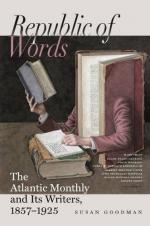There has also been given such an artist,—a woman altogether truthful, strong, and nobly delicate; and although several years have passed since she left Italy, her representations of scenery peculiarly Italian are too remarkable to be passed unnoticed. Indeed, this lady, Miss Sarah Jane Clark, is the only artist whose works are illustrative of a style of simple Landscape Art which unites in itself the love and conscientiousness of early Art and the precision and science of the modern. Her picture of Albano is wonderful,—not from the rendering of unusual or brilliant effects, but from a sense of genuineness. We feel that it grew. The flower and leaf forms which enrich the near ground are such as spring up on days like the one she has chosen. Another month, and new combinations would have given another key to her work and rendered the present impossible. In that real landscape had wrought the secret vitality clothing the earth in leafage and bloom. In its representation we see that a still more refined, a diviner vitality, has evolved leaf, flower, and golden grain. Another fact associated with this painting, as well as with some of its companions, is its character of restraint.
Temperance in Landscape Art is very difficult in the vicinity of Rome. In this picture the scene sweeps downward, with most gentle and undulating inclination, over vast groves of olive and luxuriant vineyards, to the Campagna with its convex waves of green and gold, on which float the wrecks of cities, out to the sea itself, not so far away as to conceal the flashing of waves upon the beach. Daily, over this groundwork, so deftly wrought for their reception, are cast fields and mighty bands of violet and rose, of amber and pale topaz, of blue, orange, and garnet, upon the sea. It is as if an aurora had fallen from Arctic skies, living, changeful, evanescent, athwart sea, plain, and mountain. Here is sore temptation for the colorist; more, perhaps, than by the wealth and combination of tints, he is affected by their celestial quality. All is prismatic, or like those hues produced by the interference of rays of light as seen in the colors of stars. Gorgeous as are these phenomena, they are also as transitory; and although the scene is repeated, it is with such subtile and such great changes as to remove it from the grasp of the painter who wishes to study his work wholly from Nature. The eye must be quick and the brush obedient, to catch the fleeting glories of those Alban sunsets. Even the imperial hand of Turner could give us only reminiscences.
The allurements to adopt a style of coloring involving these effects must have been great to one whose love of color amounted to a passion. Only a still greater love could have drawn her of whom we speak to the more subdued, but higher plane upon which she stands,—and that must have been a love of truth, and of that which has appealed to her nature through repetition’s sweet influences. This




